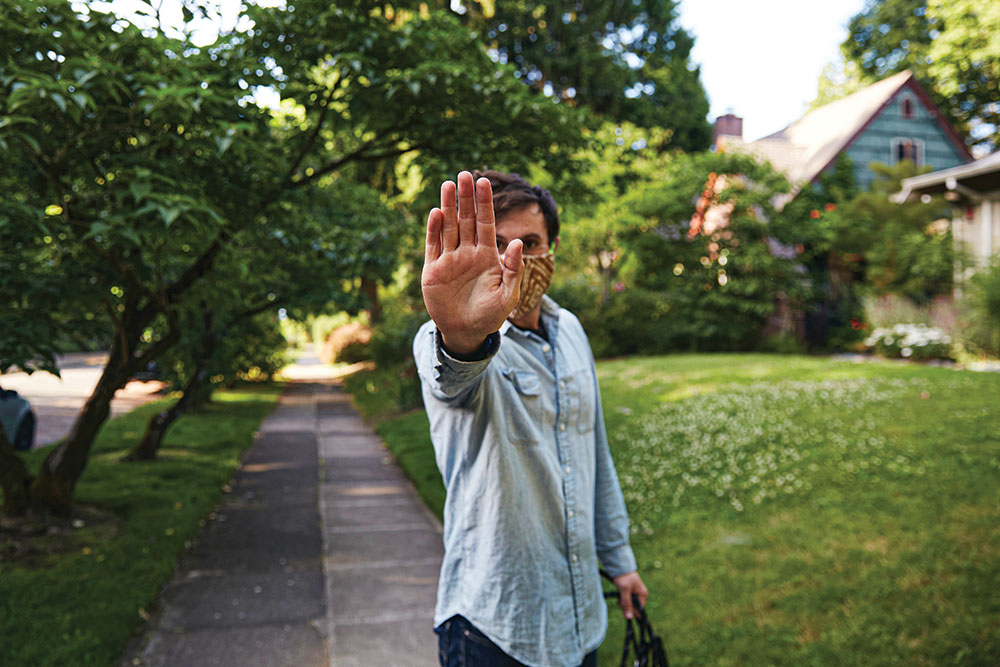Learn to use your voice to de-escalate threatening situations.
The 1980s had some of the best movies. Sure, a lot of them were corny and contained too many themes of “coming of age,” decadence and extreme idiocy, and the gun handling in them was truly horrible. But good lessons can be found anywhere, including the 1984 comedy, Police Academy, which often focused on the importance of verbal commands.
Despite the slapstick nature of this series of movies, all seven of which received mixed reviews, they contained the importance of verbal commands. “Laverne Hooks,” played by Marion Ramsey (who died earlier this year), is a meek, little woman with a squeaky voice who shows that verbal commands given in a rough, authoritative voice can be quite effective in defense. In each of the movies, Hooks really backs folks up with an authoritative growl and a grim look in her eye
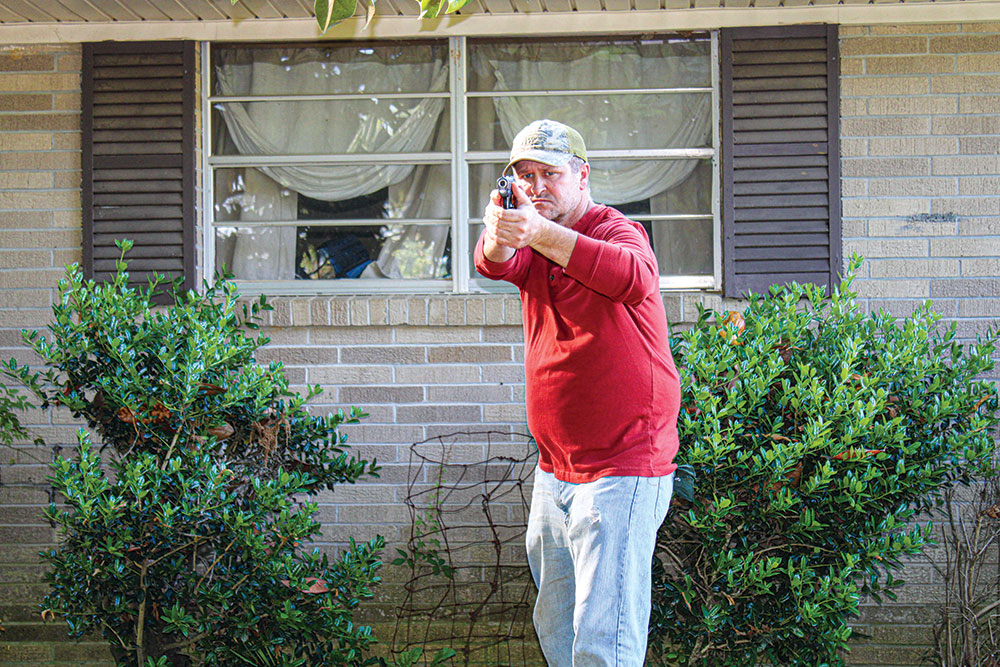
In fact, verbal commands are included in the fundamentals of threat response, according to Tiger McKee, the director of Shootrite Firearms Academy. These fundamentals include “move,” “communicate,” “use cover,” “shoot” (if necessary) and “think.” The mind should always be working, searching either for an advantage or a way out, during a self-defense situation.
“Verbalization should almost always be used in a violent encounter, either against the assailant or with companions and bystanders.”
“Fighting is problem-solving at high speed,” McKee says. “But notice that ‘communicate’ is number two on the list.”
Verbal commands are part of communication, meaning they can be used both against attackers and in conjunction with partners. People can use verbal commands to de-escalate a situation or inform a partner of intentions, as well as let an attacker know that they mean business.
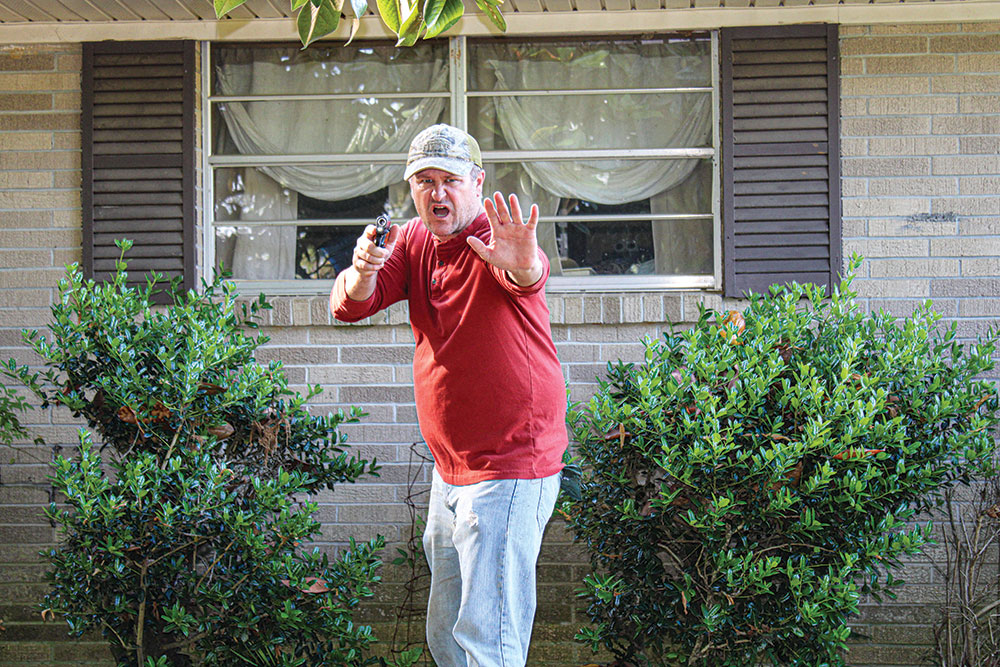
Going Verbal
Verbalization is an extremely important factor in self-defense. It’s also a good way to prevent having to pull the trigger. Words are how people communicate, both in conversations and in disagreements. In fact, simply talking to an agitated person in a calm voice can solve some disagreements.
The police prove this pretty much every day when dealing with victims, handing out tickets for minor offenses and negotiating surrenders with agitated criminals. Officers also have to deal with both the media and the general public in a professional manner. People should follow that lead when dealing with a potentially bad situation on the street.
“Verbalization is an extremely important factor in self-defense. It’s also a good way to prevent having to pull the trigger.”
Referencing Colonel Jeff Cooper’s color code of conditions of readiness, the situation being discussed is when one would go from “Condition Yellow” (relaxed awareness) to “Condition Orange” (heightened awareness to a potential threat). If possible, one would evade or de-escalate the situation to prevent having to go to “Condition Red” (ready and expect to fight or act).
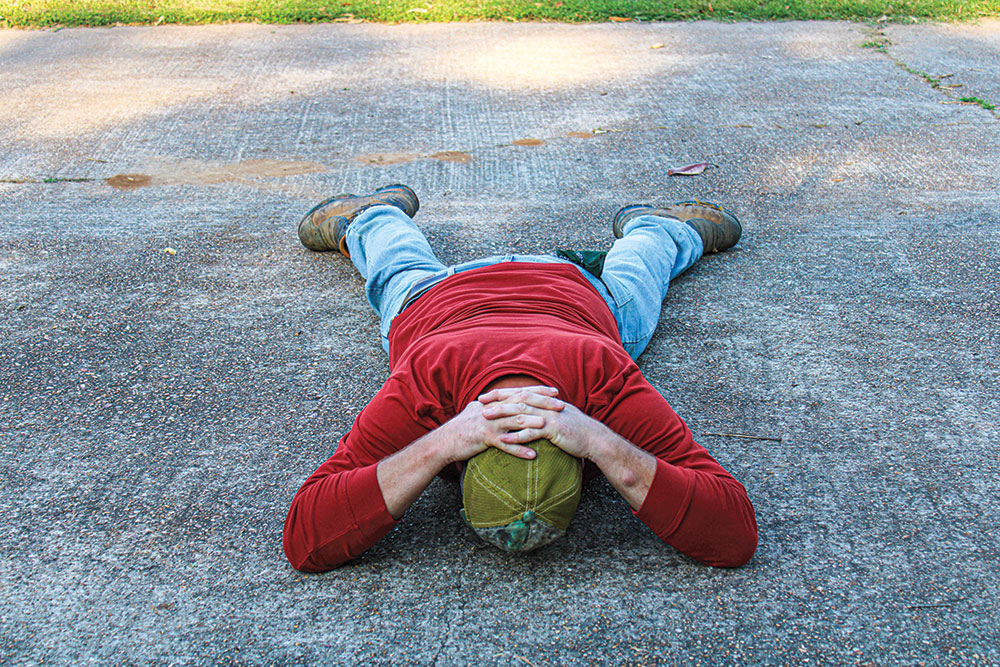
This could be anything from a homeless person yelling at a passerby to a person approaching in a threatening manner or even a customer screaming at a clerk. While many situations can, and should, be avoided if possible, sometimes, those with the means must step into situations to protect others … hopefully, with words instead of force.
Of course, police officers receive training to handle a variety of interactions with the general public, because they must be able to talk gently with victims and in a tough manner with suspects to learn the facts around a crime. Unfortunately, most folks completely overlook verbalization in regard to training.
“ … loud gets heard. Why else would every sergeant, from drill to first to gunny, use a loud, authoritative voice when giving orders?”
This, according to McKee, is a major mistake. Verbalization should almost always be used in a violent encounter, either against the assailant or with companions and bystanders. And, being able to go verbal under extreme stress requires training and practice. After all, a gunfight is nothing like those depicted in movies.
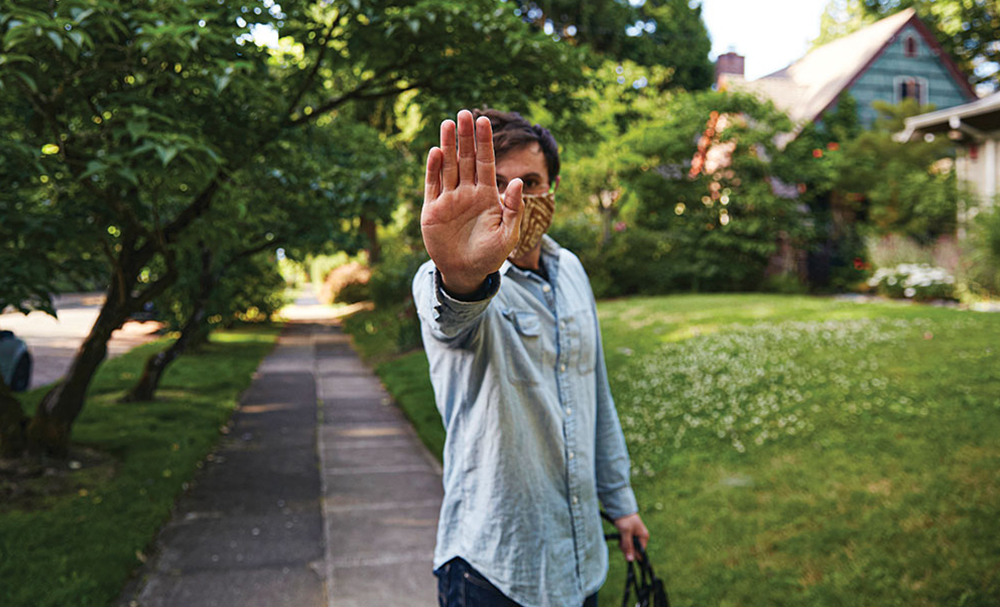
Team Communication
People are social beings who often gather in small and large groups, both inside and outside homes. And while social interactions have been limited in the past year, folks still enjoy going out for dinner, to the movies and shows, and more. Whether they’re a couple or part of a group, bad things can happen to them, including a robbery or lethal attack. Even a small group of men walking down the street can be attacked—particularly in large cities that have limited police powers and funding.
Of course, the most likely situation will involve a couple focused on each other and preoccupied with hiking a trail, shopping or simply enjoying time together. If something bad happens during this time, the pair needs to understand how to work together as a unit, even if only one is armed.
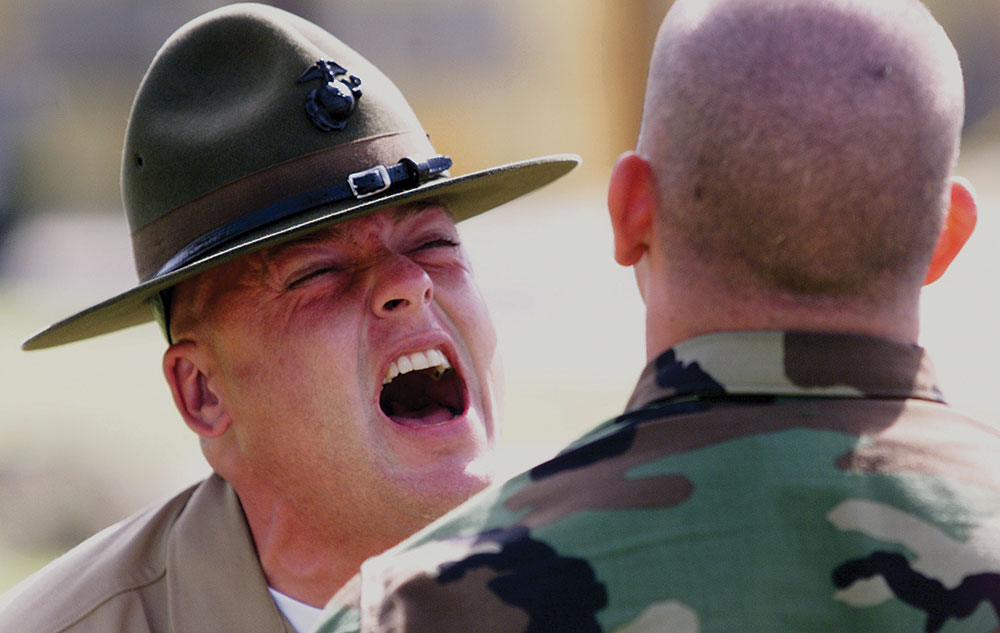
On the other hand, according to McKee, if both are armed, it’s typically better if just one takes the lead. However, “that role can shift, according to the dynamics of the situation,” he points out.
If the situation changes, and the secondary defender has to take the lead, it’ll happen quickly. In any case, the benefit of having a partner only happens with plenty of communication.
McKee also recommends concise communication in an altercation. One partner informs the other of a need or want, and the other responds. For example, the primary person says, “Moving left,” and the secondary person responds with, “Move left.” Then, the primary performs the action while saying, “Moving.”
“ … being able to go verbal under extreme stress requires training and practice.”
In his classes, McKee also stresses that teams stay away from words such as “no” and “go,” because they sound too much alike, particularly when people are under stress. Communication must be clear to be concise, and coordinating with a partner can be difficult.
As a result, McKee claims that “communication is mandatory” when a pair is defending against an attack.
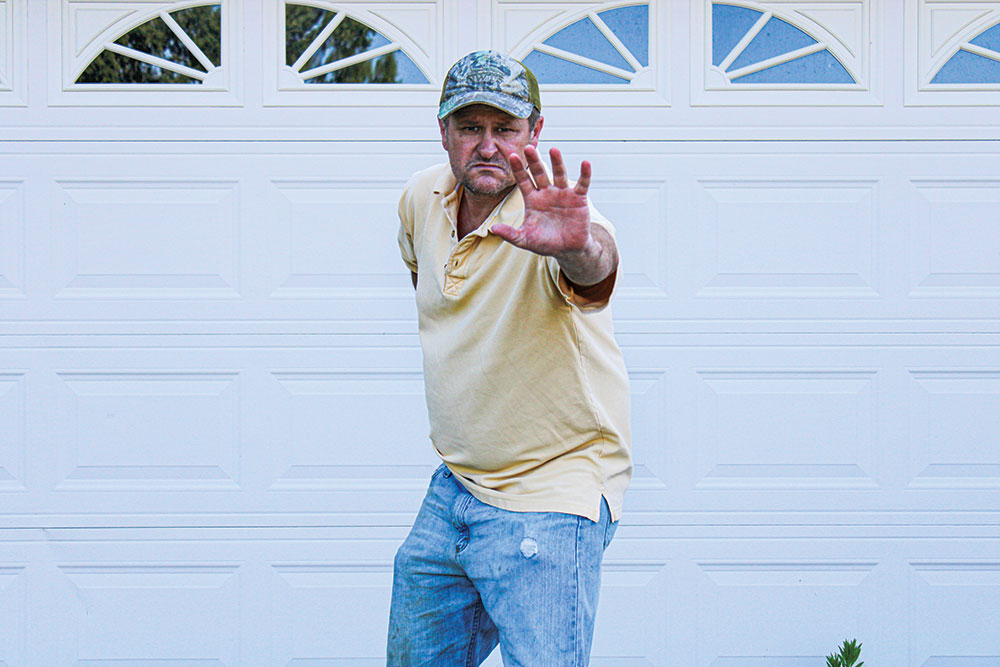
Command Voice
As shown by the previously mentioned movie character, “Hooks” (as well as by every screaming kid everywhere), loud gets heard. Why else would every sergeant, from drill to first to gunny, use a loud, authoritative voice when giving orders?
It’s no different when confronting a threat on the street: The command voice tells a potential assailant not to come any closer, to drop a knife or a gun, or even to get on the ground to wait for the police. In fact, police officers often use the command voice to subdue suspects without physicality (which can lead to someone getting hurt).
“’Fighting is problem-solving at high speed,’ McKee says. ‘But notice that “communicate” is number two on the list.’”
Something that many people don’t realize is that lots of folks were never allowed to yell, especially younger ones. In fact, McKee claims that some police recruits have to be taught to yell and be heard. Those who want to prevent having to pull the trigger in an attack must learn to bark their commands with authority. And, the most important verbal command everyone needs to learn is quite simply, “Stop!”
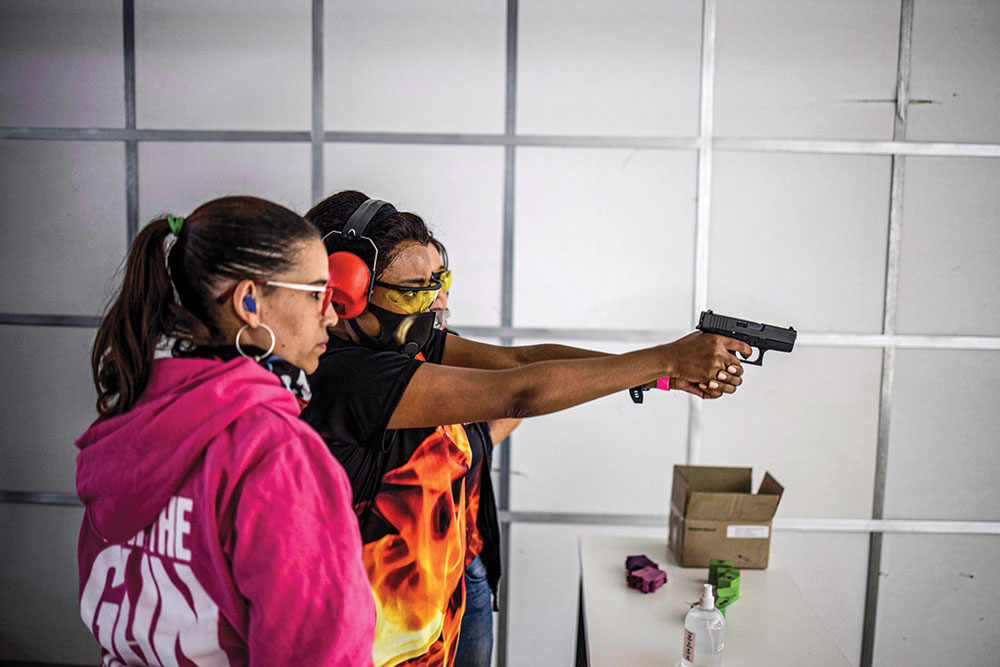
“Stop!” can mean many things, depending on how it’s used. However, in this situation, it quite literally means to end forward movement, like a stop sign, along with a nice, hefty dose of, “Don’t do that.” The word is also a warning that can be used to show that a person is willing to fight back against an attack. This often sends an assailant in search of another victim, because criminals typically prefer easy targets.
However, a verbal command must be given with authority—and without politeness. Telling an assailant, “Please stop,” isn’t going to work. It comes across as weak, which is what criminals look for in a victim.
Significance of Verbal Commands
Learning to use verbal commands is both simple and difficult: Yelling out commands isn’t hard, but doing so at the range with numerous other shooters around can feel awkward and conspicuous. This is a major reason many shooters overlook verbal command training.
Nevertheless, McKee claims that verbal commands are crucial in self-defense, which is why he introduces verbal commands early in his training courses.
“Your words carry much more weight when a pistol is in hand and pointing in a safe, low-ready position,” he explained.
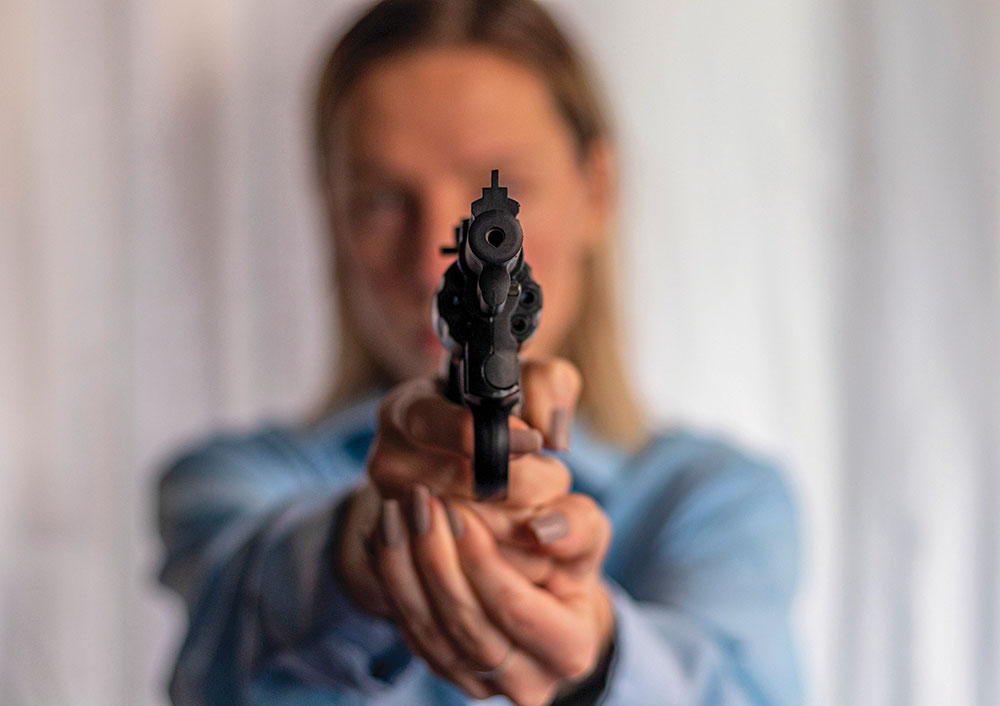
In fact, verbal commands, along with a firearm, stop countless problems every year without the defender having to fire. McKee calls this a “psychological stop: You’ve changed their mind about what they thought they were going to do.”
Verbal commands also draw attention to the situation, providing witnesses who can identify the good and bad actors and the details surrounding the attack. This can be crucial, particularly in areas where the suspects might have friends willing to mislead police.
Verbal Training
Those truly interested in using verbal commands and communication in a lethal-force situation need to train in the discipline.
“Those truly interested in using verbal commands and communication in a lethal-force situation need to train in the discipline.”
Clearly, it’s fairly impossible to train to work with everyone, which is why defenders need to train to clearly communicate directions to others in the event of an attack. Of course, couples and families also need to discuss what to do in the event of an attack, especially in regard to communication techniques. It’s even better if couples can actually train together.
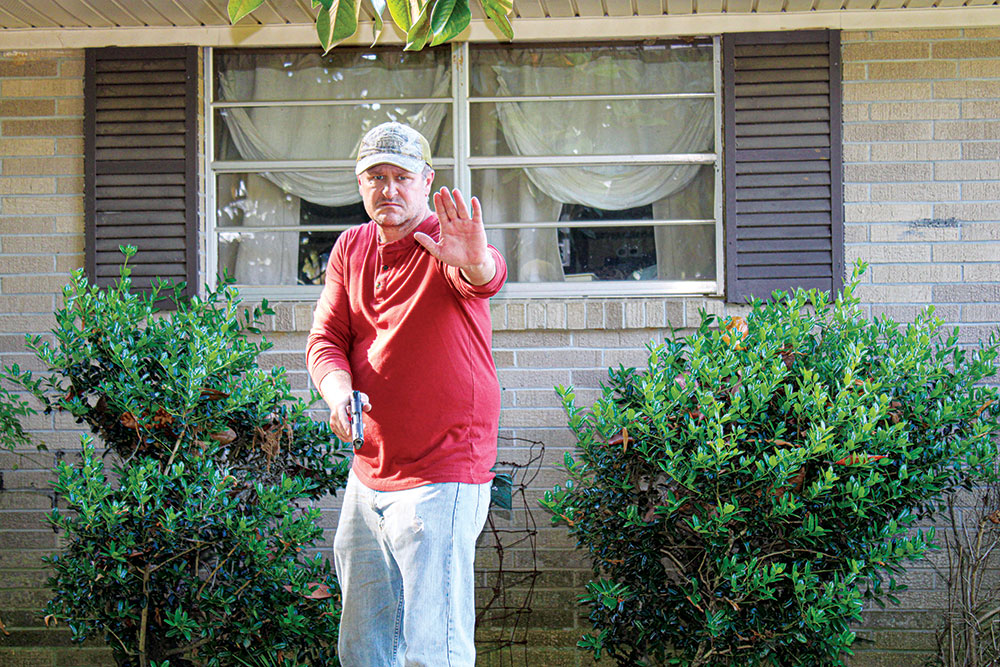
Nevertheless, whether you’re training with a partner or alone, you can start at home. In fact, one of the best places to begin verbal command training is in front of a mirror.
Start with an unloaded, concealed-carry firearm and holster (it would also be a good idea to let your family members know about the training before they hear or see it). Then, draw from concealment while yelling, “Stop!”
From there, the situation can go a few ways, and defenders need to train for all of them:
First, the attacker stops and runs away. At this point, defenders need to make sure the area is clear and call the police.
Second, the suspect stops but doesn’t run, requiring defenders to hold in Condition Red—with a gun out and, again, calling the police. As long as the suspect has mobility, he or she has the ability to attack. Here, people must also work to avoid getting “tunnel vision” on the suspect, because other attackers could be in the vicinity. Train to stay on the phone with the police dispatcher while scanning the area for other dangers.
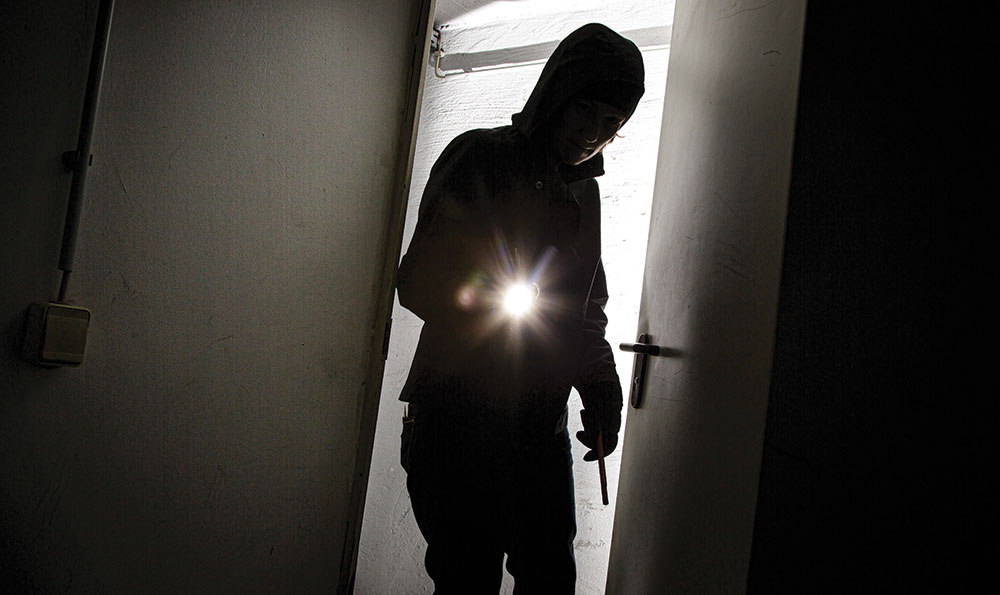
Finally, the aggressor doesn’t respond to verbal commands backed up with a gun, and shots are fired. If this happens, be sure to communicate with partners and bystanders, if needed. Also call the police, document the situation, and try to convince witnesses to stick around to provide what could be essential details. Additionally, a cell phone camera can be a defender’s greatest witness.
Each of these situations can be trained for at home, including communication with bystanders, which typically boils down to yelling, “Get down!” Of course, it’s always better to train at the range.
Team tactics can be difficult, because most firing ranges don’t allow movement. In addition, ear protection is typically involved, making it difficult to hear and understand.
Instead, consider going the dry-fire route at home, which provides the added benefit of training in house-clearing. Make sure your guns are completely empty before running scenarios, such as a single assault on the street or a pair of assailants, both with the pair coming from the front or back and from opposite directions.
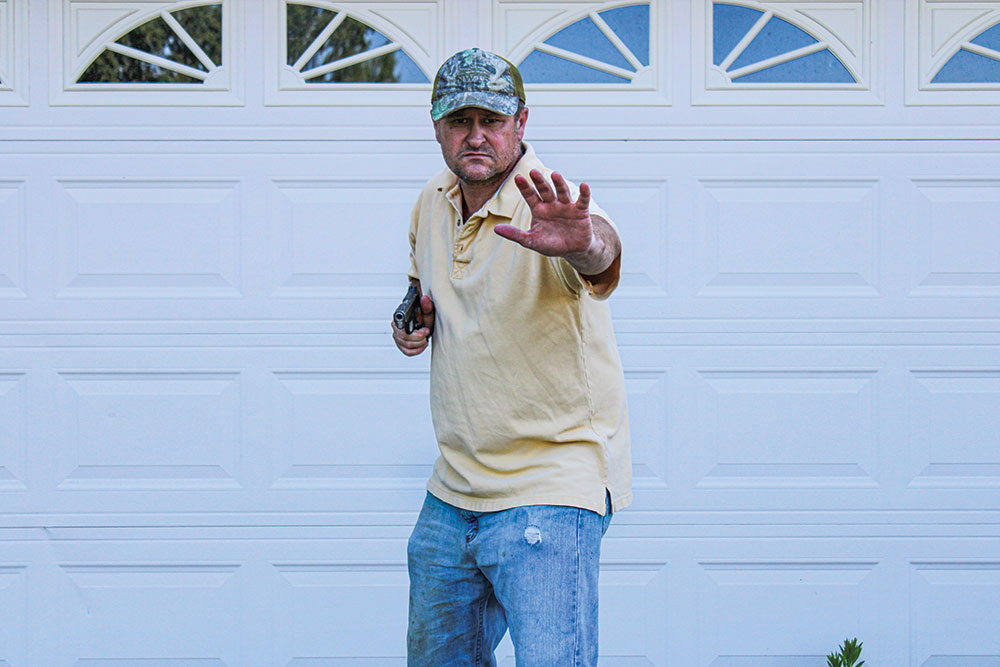
Draw and command the attacker to stop, with your gun in the low-ready position. Then, run the drill multiple times in different scenarios: with the suspect running away, surrendering and shots fired. Imagine in each situation what to do and then do it. Having a partner randomly throw out the suspect’s actions makes the situation more realistic and intense. These maneuvers also make excellent force-on-force drills using air soft guns.
The main thing to remember is to be sure to use a loud, authoritative voice, even during training. Those who squeak like the mousy “Laverne Hooks” during training will never command on the street.
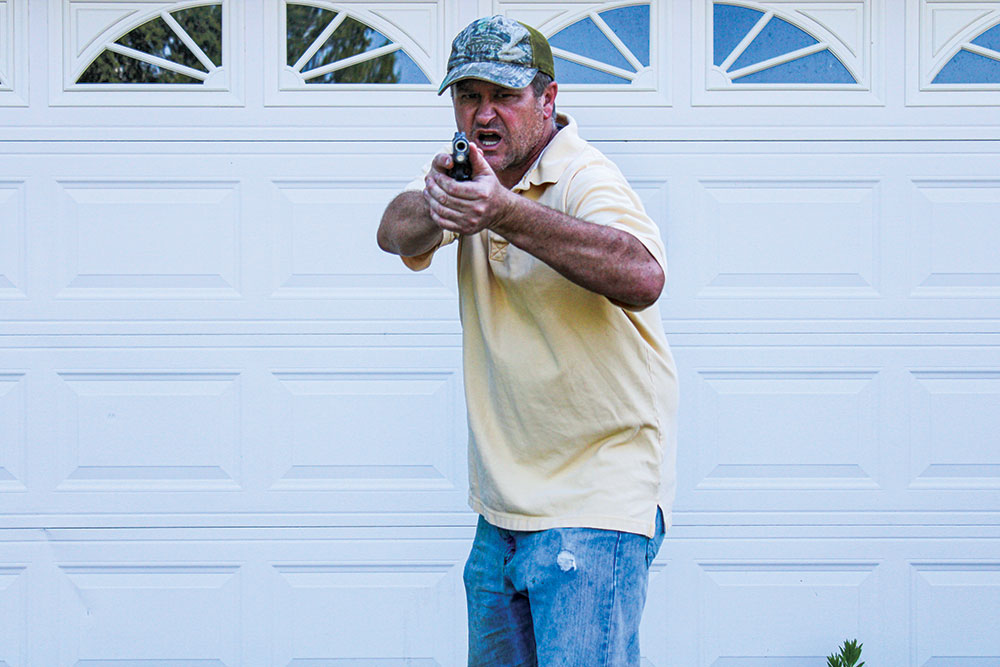
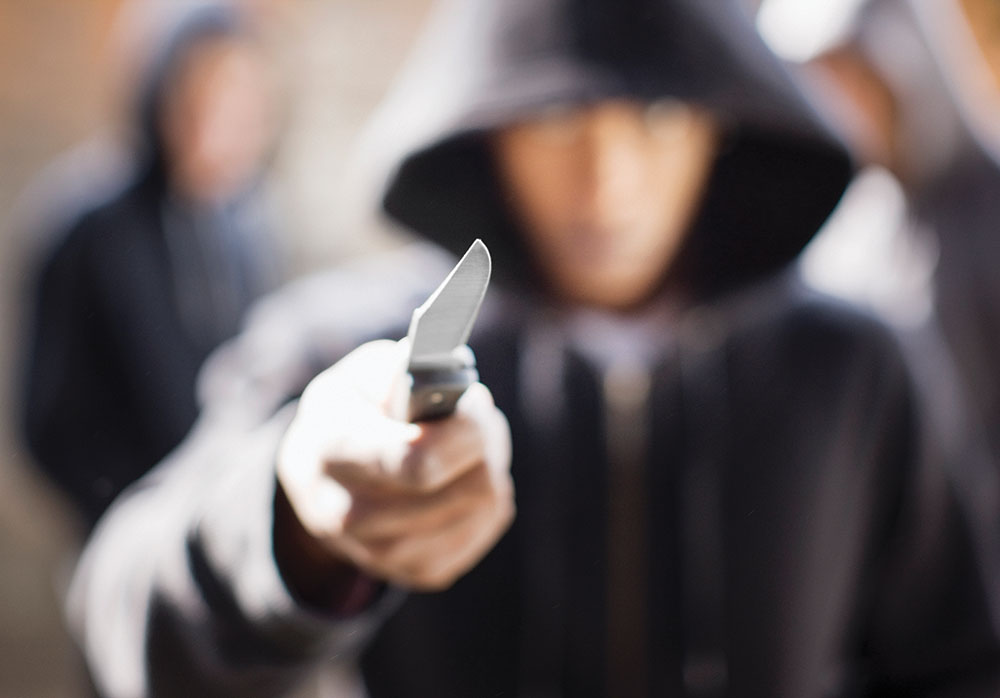
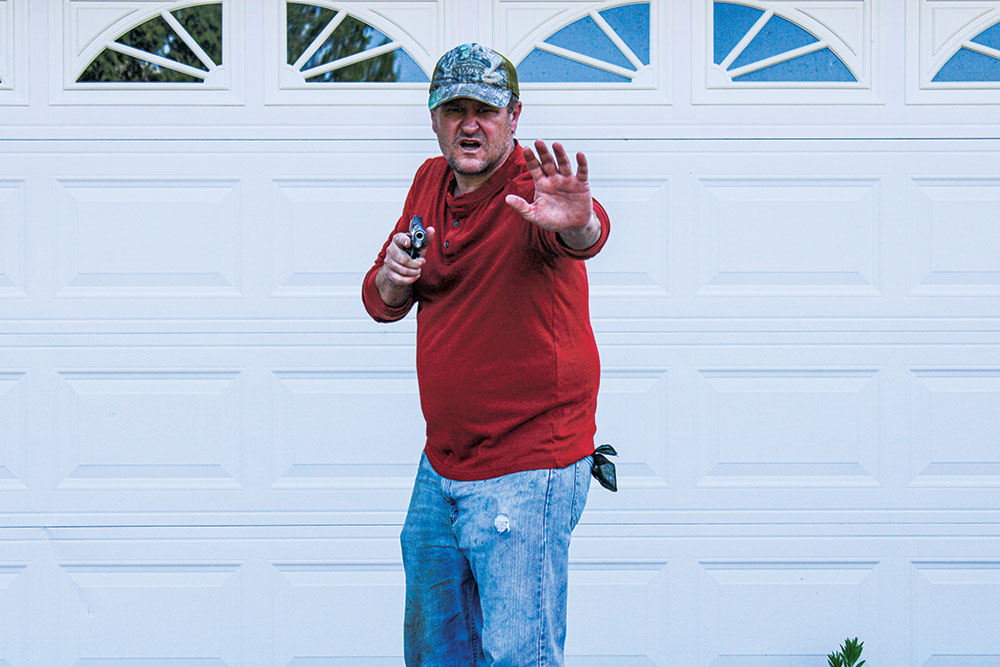
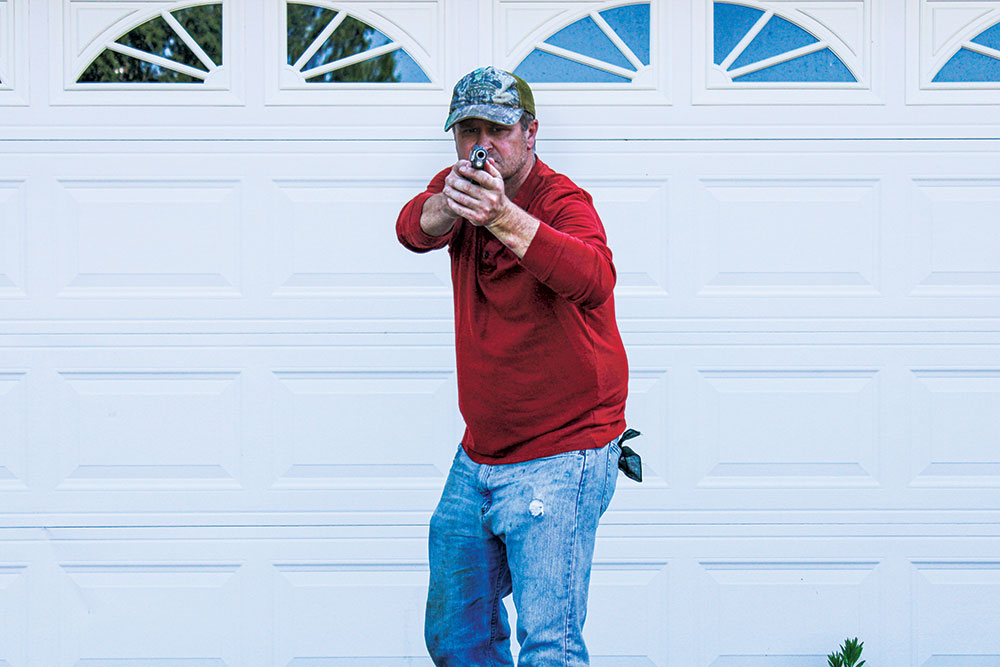
Draw, Command, Dial 911
In a situation where the suspect runs off at the sight of a gun, it’s tempting to just go about your business and not worry about reporting the assault. After all, no one was hurt or killed, nor were any shots fired. It just seems logical to not cause more paperwork for overworked police officers.
This is a huge mistake.
Pretty much every cop out there will tell you to report the crime, regardless of how insignificant it seems, because—
- You might not be the only person the suspect has attacked.
- You might be able to offer better details than others, possibly providing identification for capture.
- The suspect will probably continue the spree, meaning that they might accost others who might not be able to fight back and might get hurt … or worse.
- Any bit of information can lead to an arrest, and it’s a citizen’s responsibility to help take such people off the streets.
However, the most important reason to report every incident is that criminals are dishonest individuals who, in general, have no problem hurting others. So, it doesn’t seem that big a stretch to think a criminal might call the police and try to use the law to lash out by getting friends to lie and say you were the aggressor.
Investigators are intelligent and can probably figure out what’s really happening. However, they have to have evidence to prove theories; and fighting charges, even fraudulent charges, can take a lot of your time and money.
It’s just a heck of a lot easier to call the police and get your version on the record.
Shootrite Training
When it comes to self-defense, a good concealed-carry gun is very important. It needs to be small enough so you’ll actually carry it but large enough to be of effective caliber and carry enough rounds to be useful. Defenders often spend huge amounts of money to find the perfect gun for themselves. Unfortunately, most of those folks never spend a dime on learning to properly use that gun.
Training is just as important—if not more important—than a gun, because a gun is only a tool. Tiger McKee teaches this concept at Shootrite Firearms Academy, the training school he founded in Alabama.
When McKee got into self-defense, he went all the way, training with some of the best instructors in the world. This included Clint Smith and Colonel Jeff Cooper, who personally awarded McKee an “expert” rating with both a handgun and a rifle.
Since then, McKee has helped numerous police agencies develop training regimes. These agencies include divisions of the F.B.I.—meaning that he’s helped train some of the United States’ most elite law enforcement agents.
He’s also written two gun books and continues to train and study in the defensive use of firearms, as well as teaching others the skills he’s developed over decades of training.
Learn more about Tiger McKee and his training school at Shootrite.org or on Facebook (@Shootrite Firearms Academy).
A version of this article first appeared in the September 2021 print issue of American Outdoor Guide.


